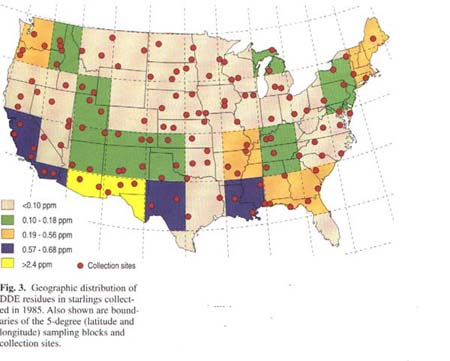
I. Definitions
A. The study of harmful effects of chemicals on ecosystems
B. Ecotoxicology integrates the ecological and toxicological effects of chemical pollutants on populations, communities, and ecosystems with the fate of such pollutants in the environment.
II. History
A. The term ecotoxicology was first used in 1969.
B. Rachel Carson and the publication of Silent Spring in 1962 had an instrumental role in raising public and lawmaker's awareness to the dangers of using chemicals.
III. Goals of ecotoxicology
A. Data for assessment and management
1. Exposure
a. How are organisms exposed?
b. How much are organisms exposed? (One part per million (ppm) is equivalent to 1 drop in an 11 gallon gas tank.)
2. Effects: How are organisms affected?
a. Concentrations present.

b. Lethal doses or concentrations

c. Endpoints (or the outcome of the effects of contaminants) can include any stage of an organism's life history. For example, DDT caused eggshell thinning; PCB's have been implicated in morphological deformities in bird bills.
B. Developing general principles
1. Bioaccumulation: means that a chemical is retained in an organism and not excreted.
2. Bioconcentration: chemicals that are stored in the body are concentrated at higher trophic levels (A hypothetical example: 0.01 ppm of a contaminant in water; 0.1 ppm in phytoplankton; 1 ppm in zooplankton; 10 ppm in small fish; 100 ppm in large fish)
3. Dose-response curves are used to predict effects of contaminants on individuals.
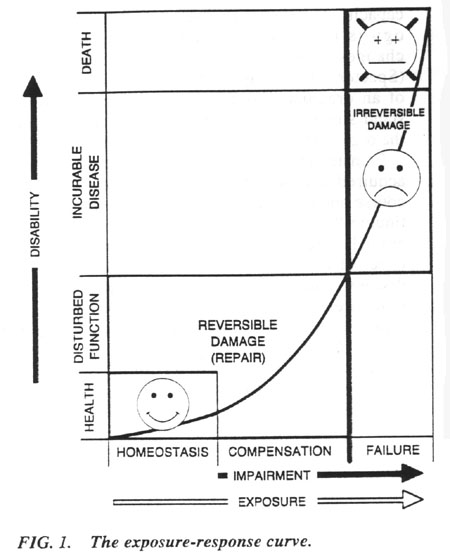
4. Models of movement through ecosystems are used to understand where contaminants become concentrated and how they breakdown in the environment.
5. Structural models of chemicals are used to attempt to predict whether a chemical may mimic natural chemicals in the body such as hormones or neurotransmitters.
C. Meeting legal requirements
III.Contaminants of concern and the current status of chemical use.
A. There are an estimated 87,000 chemicals in use.
B. Pesticides are used widely in agriculture to increase production.
C. Industrial air and water pollutants are wastes collected as a result of manufacturing the goods that we consume in everyday life.
D. Regulations have improved air and water quality.
1. The Cuyahoga River was so polluted before regulations of the Clean Water Act that it caught on fire in 1952 and in 1969.
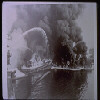
2. Air pollution is declining overall.
3. Wildlife are recovering from the effects of contaminants, such as DDT.
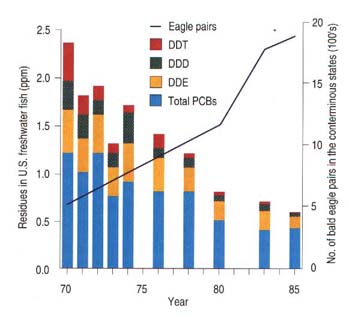
E. Chemicals vary in the degree of persistence in the environment. Even when they breakdown, the resulting compounds may also be harmful.
F. Current chemicals (such as organophosphates and carbamates) in use are typically shortlived, but they may have more acute effects.

IV. Endocrine disruptors
A. Definition: Endocrine disruptors include all chemials that interfere with the normal functioning of the endocrine system, such as pharmaceutical drugs intended to modulate the endocrine system; phytoestrogens which are naturally occurring estrogenic compounds B. B. Effects linked to endocrine disruptors
1. In wildlife: male feminization, deformities, reproductive problems.
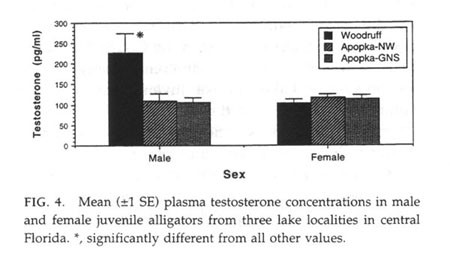

2. In humans, there are controversial studies indicating links with deformed male sexual organs, increased risk of endometriosis, decreased cognitive abilities, and declining sperm counts

C. Studying endocrine disruptors is challenging for ecotoxicologists.
1. Hormones operate at very low doses
2. Critical periods determine large, long-term effects
3. Possible synergistic effects of contaminants also must be considered
D. Current work on solutions
1. In 1993, Congress required the EPA to develop a screening and testing program for all chemicals.
2. Program has been developed and involves screening chemicals. Those chemicals that do interact with the endocrine system will undergo testing in 5 major taxa, including representative from both vertebrates and invertebrates for effects. Endpoints include a range of life history stages.
3. Implementation begins August 1999
4. Progress report due August 2000
V. PCBs and the Hudson River
Contamination of the Hudson River by Polychlorinated Biphenyls (PCBs) is an ongoing environmental issue in New York State and at the EPA. PCBs represent a class of some 209 organochorine compounds and are extremely stable chemically. They do not burn easily and do not conduct electricity, and these properties made PCBs ideal for use as insulators in capacitors and transformers used by power. They were used extensively by GE at two power plants on the upper Hudson. Wasteful practices (no recycling and sloppy practices) led to prodigious amounts of PCBs being dumped into the river (1.2 million pounds). Given production amounts of PCBs world wide, it is estimated that for every 1000 pounds of PCBs produced, 1 pound was dumped into the Hudson River. PCBs are heavier than water and sink into the river sediments where they are ingested by aquatic organisms living in the sediments. Bioaccumulation and bioconcentration transfer and increase the levels to higher trophic levels as predation occurs. The commercial fishing industry has been closed. Top carnivores are conspicuously absent along the upper Hudson River. To assess the impact of PCBs on wildlife, the US Fish and Wildlife Service has conducted assessments measuring the amount of PCBs in wildlife as well as measuring effects on reproduction. Not surprisingly, wildlife along the Hudson have alarming quantities of PCBs. One species, the Tree Swallow, has been the focus of an in depth study and used as an indicator species to assess how healthy the ecosystem is. Tree Swallows are aerial insectivores, which means they eat insects on the wing. The larvae of many of these insects develop in aquatic environments prior to emerging as winged adults and are exposed to contaminants such as PCBs in the sediments. PCB levels have been measured in Tree Swallows at other contaminated sites, but along the Hudson, the highest levels ever recorded in Tree Swallows occur. In comparison with an uncontaminated site in Ithaca NY, swallows along the Hudson have higher nest abandonment rates and lower hatchability of eggs, suggesting that contaminants are adversely affecting reproduction. PCBs are an endocrine disruptor and hormones are known to be involved in parental care behaviors, such as incubation of eggs. Currently, the flow of the river around the contaminated site has been diverted to minimize futher leaching of PCBs from the porous shale foundation of the plant into the river. The extent to which GE will be responsible for the clean up is an issue that is currently being debated.